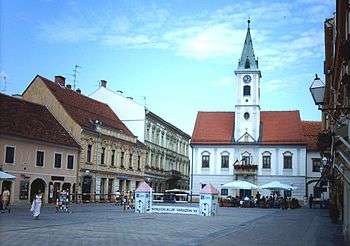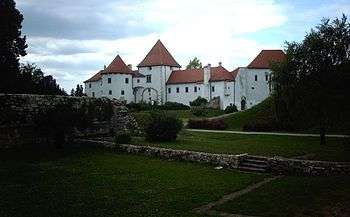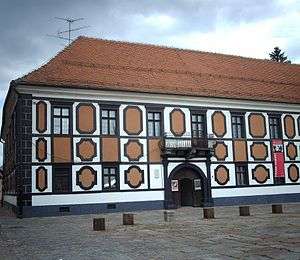Varaždin
Varaždin is one of the most important tourist centers of northern Croatia. The old town fortification, the central part of the town, numerous museums, galleries, collections, and the Varaždin cemetery, protected as a horticultural monument, represent the main tourist attractions of this Central European Baroque town and ancient Croatian capital. Varaždin is located on the right bank of the Drava river in north-western Croatia, 79 km north of Zagreb.

Understand

The first written reference to Varaždin was in 1181, when the nearby thermal springs Varaždinske Toplice were mentioned by King Bela III in a legal document.
In 1209 Varaždin was declared a free royal borough by the Croatian-Hungarian King Andrew II which allowed it to develop into the economic and military centre of northern Croatia. Due to the frequent Ottoman raids, the town was structured defensively around the old fortress, thus acquiring the shape of a typical medieval Wasserburg. As early as the 13th century the Knights Hospitaller (in Croatian Ivanovci) came to Varaždin, where they built a church and a monastery.
At the end of the 14th century the Varaždin fortress passed into the hands of the Earls of Celje. Over the following centuries Varaždin had several owners, the most influential being Beatrice Frankopan, Margrave Juraj of Brandenburg, who built the town hall; the last was Baron Ivan Ungnad, who reinforced the existing fortification. When at the end of the 16th century Count Toma Bakač Erdödy became its owner, assuming the hereditary position of Varaždin prefect (župan), the fortress remained in the ownership of his family until 1925.
In 1756, Ban Franjo Nadasdy chose Varaždin as his official residence turning Varaždin into the capital of all of Croatia. It hosted Croatian Sabor and the Royal Croatian Council founded by Empress Maria Theresa of Austria.
Reformation and the counter-reformation left a lasting mark on Varaždin. With the arrival of the Jesuits, the school and the convent were founded. Furthermore, a number of churches and monasteries were built in the baroque style. As Varaždin was the seat of many Croatian noblemen in 1756 it became the administrative center of Croatia. However, when the great fire of 1776 destroyed most of the town, administrative institutions moved back to Zagreb.
By the 19th century Varaždin had been completely rebuilt and expanded. Crafts and commerce, and later the manufacture of silk and bricks flourished resulting in the creation of the town's theatre, music school, and fire department.
Get in
Due to its advantageous location, the town is easily accessible to many neighbouring countries.
By bus
Buses are very frequent from Zagreb and take around 90 minutes - check the timetables or the Zagreb Bus Station's website for times. Services into the neighbouring areas are quite frequent, some going over the border into Hungary. Buses also leave from other major Croatian cities almost daily for Varaždin. Online information for buses to Varaždin can be found at the Varaždin Transit website.
International departures (especially for Austria, Germany, Hungary and beyond) often make a stop in the town, and if there is a later bus that day, companies normally honour a 'break of journey' to visit the town for a few hours.
In Varaždin the bus station is on the western side of town, and the railway station is on the eastern side, around 2 km away.
By car
Those travelling from Graz in Austria should proceed to Maribor taking the M3 road to Ptuj from which they can cross into Croatia.
Travellers coming from Nagykanizsa or Budapest should use the A4 motorway once they enter Croatia which connects Varaždin with the Hungarian border.
Travellers from Zagreb can use A4 motorway which will take them to their destination in less than an hour.
By train
The most scenic and cheapest (but slowest) way to get to Varaždin from Zagreb is a local train (2hr 20min) stopping at every station between the two cities. The price of a return ticket is 80 kn, with discounts for ISIC card holders. The speed of the journey dramatically improved with the addition of a faster (though more expensive) alternative of the high-speed tilting train connection operated by Hrvatske željeznice (Croatian railways).
Train services also operate north to Čakovec and Koprivnica (with further connections to Slavonia and Hungary), and there is a daily service to Split and to Budapest in Hungary.
Get around
See

- Stari grad (Old city). is a beautiful medieval fortress. Although its construction began in the 14th century, it was greatly expanded in the 15th century when the rounded towers that typify the Gothic architecture of northern Croatia were added by the Earl of Celje. In 1925 it was turned into Gradski muzej (Town museum) | url=http://www.mdc.hr/varazdin/eng/1-kulturno-povijesna.html | email=
| address= | lat= | long= | directions= | phone= | tollfree= | fax= | hours= | price= | content=Which houses paintings, furniture, weapons and decorative objects important for the Varaždin's history. In 1994, it was the first Croatian museum nominated for the European Museum of the Year Award. (Tu-F 10:00-17:00; Sa Su 10:00-13:00; Closed on M. +385 42 43-712, +385 42 212-918) }}
- Galerija starih i novih majstora (Gallery of Old and Contemporary Masters). Hosted in the rococo-style Sermage Palace built in 1759 and donated to the museum by the City of Čakovec in 1947. The gallery's holdings include over 3,000 pieces. Many old masters' works served as the basis of today's permanent collection displaying 61 paintings from the 15th to the end of the 19th century. The most valuable pieces are those by Dutch masters from the 17th and 18th centuries and the portraits by both local and naturalized masters: A. Moses, M. Brodnik and M. Stroy. The gallery also holds works by the famous Croatian contemporary masters: V. Bečić, Lj. Babić, R. Frangeš-Mihanović, as well as by a number of local painters and sculptors from Hrvatsko zagorje and Međimurje. Particularly valuable are the collections of Miljenko Stančić's and Ivo Režek's works (Tu-F 10:00-17:00; Sa Su 10:00-13:00; closed on M; Trg Miljenka Stancica 3; +385 42 214-172).
- Entomološka zbirka (Entomological Collection). Is located at the early Classicist Herzer Palace in the center of the town. The first collection was established by Franjo pl. Koščec (1882-1968), the local high-school teacher and entomologist. He donated his large natural scientific collections to the City of Varaždin in 1959. His work was, in the 1962-1980 period, continued by his daughter Ružica Koščec. Since 1903 some 50,000 specimens have been collected. The collection also includes enlarged models of certain insect species. Over the years, the holdings have been expanded by entomological material from the territory of northwestern Croatia. Its scientifically valuable collections, including several tens of thousand specimens, bring testimony of natural properties and environmental changes, thus constituting an inevitable source of information for the elaboration of the Croatian fauna inventory (+385 42 213-491).
Do
Buy
There are numerous nice souvenirs for you to buy in Varaždin. It is best to buy them from hard working artisans that have their own corner in Varaždin. The most famous of them is a Hatter (Klobučar). Owner of a small stand full of handcrafted hats has a nickname "Herc" and it's one of the most recognized man in town. Next to him is a hard working Blacksmith who crafts lovely souvenirs and next to him is a tailor with tons of souvenir clothing.
Eat
Decent lunch can be found in Zlatne ruke (Golden hands). Best place for pizza and pasta is Angelus, across the street from the city park. One can find delicious pizza in Rebus, about 10 km in Kučan (dirfections have to be added). Zvonimir restaurant provides great pizzas and there are many restaurants outside of Varazdin such as Cesljas on Varazdin breg. McDonalds is i Vrazova street. Next to the McDonald's there is Billy Kebab. The best kebap can be found in Zagtrebačka, 50 m south of the post office, and Gajeva street (same oweners). One can get pizza slices 30m from McDonald's.
There are numerous caffes in the centre. Bars with R&B music are Soho, Tiki Bar, Morgans Bar, Mea Culpa, Rock Art Caffe. Main stream alternatives can have a good time in Lavra. One can enjoy a good beer and rock music in Vienna, Caffe Theatre (formerly known az Rogoz), Kult, Sax and Old City Pub. Vienna is across the road from the town theatre, Caffe Theatre is in the theatre, Kult is 200 m from the first two bars, Sax is next to McDonald's, Old City Pub is about 200 m from Stancic Square.
Sleep
- Hotel Turist (Aleja kralja Zvonimira 1, 42000 Varaždin; telephone +385 42 395-395). A 3-star hotel with 46 single rooms, 58 twin rooms and 5 suites of total capacity of some 100 beds. The suites and the rooms are equipped with a bath, TV/SAT, telephone and a mini bar.
- Hotel La'Gus (Varaždinski breg bb, 42204 Turčin; telephone +385 42 652-940). A 3-star hotel located outside Varaždin. It has 26 double rooms and 2 suites. There is a mini bar, a satellite TV set and a direct telephone line in every room, plus a small kitchen in all the suites.
- Motel Garestin (Zagrebačka 34, 42000 Varaždin; telephone +385 42 214-314) - a new establishment within a short walk from the bus station.
- Pension Maltar (Prešernova 1, 42000 Varaždin; telephone +385 42 311-100). Has 10 rooms (with 22 beds) so booking in advance is recommended. The website is in Croatian.
Go next
- Varaždinske Toplice (Varaždin Thermal Spa) is located 12km to the south-east of Varaždin. The famous spa renowned for its warm sulphuric water were established by the Romans in the 1st century AD. These days it is a destination with a range of modern indoor and outdoor pools. Varaždinske Toplice can be reached by bus from Varažidn. The ride takes around half an hour.
- Trakoscan Castle is a stunning 12th-century fortified castle and one of the few from that period that are still standing in Europe. A major reconstruction was undertaken in early 19th century giving it a distinct neo-gothic look. It can be reached by bus from Varaždin (the bus fare costs 25 kn).
- Nagykanizsa in Hungary and Graz in Austria are also just a short distance away.